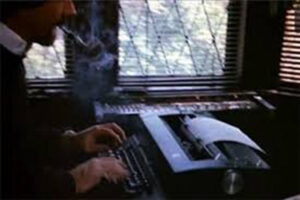What happens when you hear the word writing?
My guess is that your imagination takes you to one end of the writing experience or the other. Maybe you think first about the output of your favorite writers — you picture their books on your shelves, or in carefully-curated bookstore displays. Their oeuvres.
This is writing as finished project, fixed in time and space, waiting patiently for the interested reader. In this case, writing doesn’t call to mind the actual writer at work, only the results.
But I’m reminded of a writer from my childhood whom I did see at work, repeatedly. He can still rise to mind when I think of writing.

Stephen Cannell was a writer and producer for eighties television shows like The Rockford Files, The A-Team, and 21 Jump Street. At the end of each of his shows, a fifteen-second clip would run of Cannell in his office, surrounded by Emmys, smoking his pipe while typing in a headlong rush, without error or second thought. With a flourish, he would rip the page out of his typewriter and toss it into the air, where it would resolve into a neat pile of manuscript pages. Complete. Inevitable. Again and again I watched him perform this triumphant, extraordinarily proficient act.
At the time, the clip registered only as a mildly disappointing marker — the end of a favorite show, the cue for bedtime. It was only as I began to make my career in writing and teaching writing that I thought, Hey, wait a minute! That’s not how I do it. I don’t think that’s how anybody does it.
If your writing process looks like Cannell’s — clean copy churned out at the pace of a page a minute — then good luck and Godspeed. But the rooms I write in are never so exciting.
They are more like the opposite, at the other end of the writing experience. They are more like this:
This is a scene from “Adaptation,” a movie that is, in part, about writing. The screenwriter Charlie Kaufman had trouble adapting Susan Orlean’s book The Orchid Thief into a screenplay, so he instead wrote a movie about his inability to do so.
Another devastatingly accurate thing about this clip — besides Kaufman’s mind immediately wandering to what kind of muffin he’ll use to reward himself — is the specific block Kaufman hits. Sometimes you know, in general, what you’re going to write about. A “theme,” as Cage puts it. But where does an overriding focus on a general theme lead you? Right: staring at the blank page. Frozen. Fixed in time and space, but with nothing to show for it.
The idea of starting with “theme” is a false promise: we know good essays have themes. But themes emerge. You can’t tell us what your story’s about unless you first tell us that story.
When we tell stories, we’re immersed in those moments that mean something to us. And — crucially — we’re acting like ourselves, not trying to pretend that we’re someone we imagine the reader wants us to be.
Here’s an incomplete list of things we don’t typically think about when we think about writing: the doodled-on diner napkins, the hastily-scribbled notes on the backs of receipts, the three cryptic words on a palm: “mulch, apple, Volkswagen.” The scattered moments of potentially promising thought. We don’t think about these things because they are often only springboards. I remember the beat-up 1978 Volkswagen Rabbit in which my father drove me to an acting class. The car was twelve years old, a faded canary yellow, and its floorboards were almost rusted through. It was a long drive to the class, so I spent a lot of time in that car, beside my dad. This might be the kernel of an essay about my relationship with my father, or about the lengths we had to go to for enrichment activities in the small town where I grew up, or about the connection between these two realities. The Volkswagen is not the story, but its description is a crucial and necessary place to stand. It provides me the traction, the momentum, I need in order to get to — and to get inside of — what I’m really writing about.
So, these haphazard notes, these preludes to a draft, are signs of a process underway, whether or not the writer recognizes it as such.
At Hillside, we’re all about process, especially for college-app essayists, who can feel overwhelmed by (and misguided about) the project before them. Essayists who know only that they want to impress, to stand out, and so reach for the biggest claims they can make … and walk right into theme-thinking. This approach is likely to produce an essay that is quickly forgotten by its readers because it makes the writer sound like all the other desperate essayists trying to make general claims.
Better to start telling stories and see where they take you. Because when we tell stories, we’re immersed in those moments that mean something to us, and we’re bringing our readers back there with us, to see and hear and smell and feel what happened. And — crucially — we’re acting like ourselves, not trying to pretend that we’re someone we imagine the reader wants us to be.
As my Hillside colleague Kate Leary admits in reflecting on the experience of starting a new piece of writing, “my ideas and ambitions feel so big that it’s a challenge even to write a first sentence.” But she’s calmed and guided by Edith Wharton’s advice to “abandon the larger for the smaller field.” It’s always better to start with a remembered moment or a particular fascination in a smaller field. That’s where Hillside’s Ten Sentences Exercise can play such a useful role. It forces the young essayist to begin close to experience, to pay attention to specifics. As our founder, Allan, has said to me, “We all want the pearl, but we start with the grain of sand.” What I like about that comparison is that it’s the irritation of the grain of sand — which happens in lively conversation — that sets in motion the process that gives us, eventually, the pearl.
And it’s a process that can launch the young writer into a very different experience of what writing can be and mean.
Sebastian is a Hillside coach.




